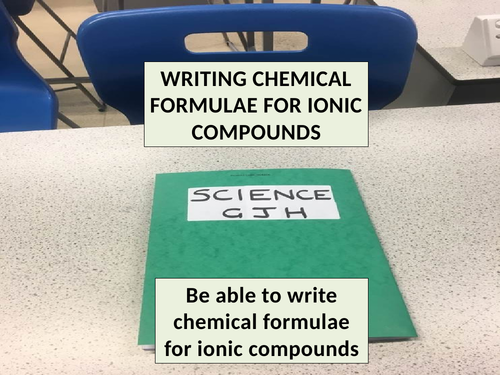

An engaging and informative lesson presentation (43 slides) that shows students how to write accurate chemical formulae for ionic compounds.
In order to write accurate chemical formulae, students need to know the charges of the ions involved. For this reason, the lesson begins by reminding students how they can use the Periodic Table to work out the charge of the charged atoms. Students are shown how they can use these ion charges to write the formula and then are given the opportunity to apply this to a number of examples. Moving forwards, students are shown how some formulae need to contain brackets. The lesson finishes with a competition called “Ye Olde Chemical Formula Shop” where students get points if they are the first to work out the formula of a given substance.
This lesson has been written for GCSE students.
Get this resource as part of a bundle and save up to 38%
A bundle is a package of resources grouped together to teach a particular topic, or a series of lessons, in one place.
Topic C4: Stoichiometry (Cambridge iGCSE Science Double Award)
This bundle of 10 lessons covers all of the content in Topic C4 (Stoichiometry) of the core and supplement sections of the Cambridge iGCSE Science Double Award specification. The topics and specific points covered within these lessons include: Use the symbols of the elements and write the formulae of simple compounds Determine the formula of an ionic compounds from the charges on the ions present Construct and use word equations Construct and use symbol equations, with state symbols, including ionic equations Deduce the balanced equation Relative formula mass Define the mole in terms of Avogadro's constant Use the molar gas volume Calculate stoichiometric reacting masses and volumes of gases Calculate the concentration of solution All of these lesson presentations and accompanying resources are detailed and engaging and contain regular progress checks to allow the students to constantly assess their understanding
Topic C1f: Ionic bonding (Edexcel iGCSE Chemistry)
This bundle of 3 lessons covers all of the content in Topic C1f (Ionic bonding) of the Edexcel iGCSE Chemistry specification. The topics and specification points covered within these lessons include: * Understand how ions are formed * Know the charges the group atoms and charged molecules * Write formulae for ionic compounds * Draw dot and cross diagrams for ionic compounds * Understand ionic bonding in terms of electrostatic attraction * Understand why giant ionic lattices have high melting and boiling points * Know which type of ionic compounds can conduct electricity and which cannot All of these lesson presentations and accompanying resources are detailed and engaging and contain regular progress checks to allow the students to constantly assess their understanding.
Topic C2: Elements, compounds and mixtures (OCR Gateway A GCSE Combined Science)
This bundle of 18 lessons covers the majority of the content in Topic C2 (Elements, compounds and mixtures) of the OCR Gateway A GCSE Combined Science specification. The topics covered within these lessons include: Elements Electron configurations Compounds Chemical formula of ionic compounds Ionic compounds Covalent substances Simple molecules Polymers Metallic bonding Diamond and graphite Graphene and the fullerenes Changing states Pure and impure substances Distillation Filtration and crystallisation Chromatography Interpreting chromatograms Relative formula masses Empirical formula All of these lesson presentations and accompanying resources are detailed and engaging and contain regular progress checks to allow the students to constantly assess their understanding.
Topic C3.1: Introducing chemical reaction (OCR Gateway A GCSE Combined Science & Chemistry)
This bundle of 9 lessons covers the majority of the content in the sub-topic C3.1 (Introducing chemical reactions) of the OCR Gateway A GCSE Combined Science and GCSE Chemistry specification. The topics covered within these lessons include: Formulae of ionic compounds Conservation of mass Writing chemical equations Writing ionic equations The mole Mole calculations All of these lesson presentations and accompanying resources are detailed and engaging and contain regular progress checks to allow the students to constantly assess their understanding.
Something went wrong, please try again later.
This resource hasn't been reviewed yet
To ensure quality for our reviews, only customers who have purchased this resource can review it
Report this resourceto let us know if it violates our terms and conditions.
Our customer service team will review your report and will be in touch.